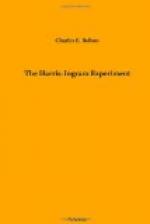Mr. Searles visited the tall Washington Building which occupies the ground where formerly stood the headquarters of Lords Cornwallis and Howe. He told Gertrude that he had read that, in July, 1776, the people came in vast crowds to Battery Park to celebrate the Declaration of Independence, and that they knocked over the equestrian statue of George III., which was melted into bullets to be used against the British.
“Yes,” replied Colonel Harris, “in early days, Americans doubtless lacked appreciation of art, but we always gave our cousins across-sea a warm reception.”
“Colonel Harris,” said Mr. Searles, “it has always puzzled me to understand why you should have built near Boston the Bunker Hill Monument.”
“Mr. Searles, because we Americans whipped the British.”
“Oh no, Colonel, that fight was a British victory.”
“Father,” said Gertrude, “Mr. Searles is right; the British troops, under General Gage, drove the American forces off both Breed’s Hill and Bunker Hill. The obelisk of Quincy granite was erected at Charlestown, I think, to commemorate the stout resistance which the raw provincial militia made against regular British soldiers, confirming the Americans in the belief that their liberty could be won.”
Mr. Searles thanked Miss Harris for her timely aid and added that a patriot is a rebel who succeeds, and a rebel is a patriot who fails. He observed also the witty sign over the entrance of a dealer in American flags, “Colors warranted not to run.”
The party drove to the Produce Exchange, one of the most impressive buildings in New York. It is of rich Italian Renaissance architecture. Beneath the projecting galley-prows in the main hall, the fierce bargaining of excited members reminded Mr. Searles of a pitched battle without cavalry or artillery.
Gertrude was anxious to climb the richly decorated campanile that rises two hundred and twenty-five feet, which commands an unrivalled bird’s-eye view of lower New York, the bay, Brooklyn, Long Island, and the mountains of New Jersey. All hoped to catch a glimpse of the “Majestic,” but she was down the Narrows and out of sight.
Mr. Searles desired to see Trinity Church, so he was driven up Broadway to the head of Wall Street. Its spire is graceful and two hundred and eighty-four feet high. The land on which it stands was granted in 1697 by the English government. There were also other magnificent endowments. Trinity Parish, or Corporation, is the richest single church organization in the United States, enjoying revenues of over five hundred thousand dollars a year. In Revolutionary times the royalist clergy persisted in reading prayers for the king of England till their voices were drowned by the drum and fife of patriots marching up the center aisle.
It was now past two o’clock and the Harris party was driven to the Hotel Windsor for lunch. Promptly at six o’clock the conductor of the fast Western Express shouted, “All aboard,” and Colonel Harris, Gertrude, and Mr. Searles in their own private car, left busy New York for Harrisville.




